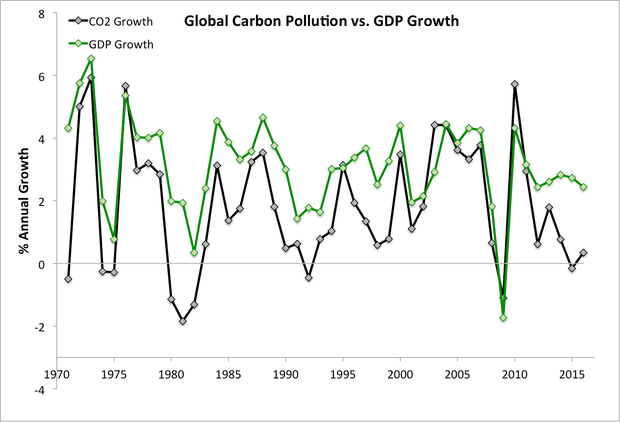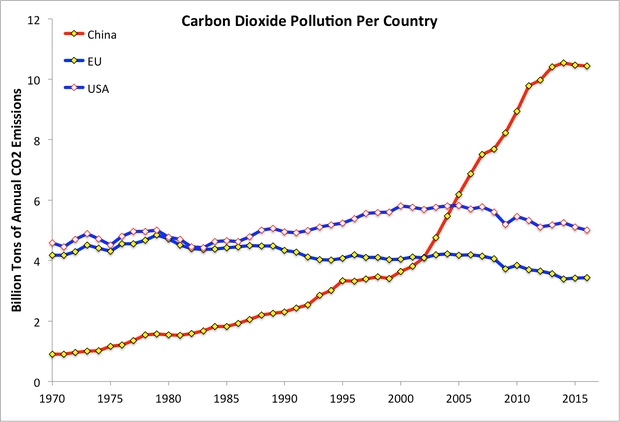
Over the past half-century, growth in the global economy and carbon pollution have been tied together. When the global economy has been strong, we’ve consumed more energy, which has translated into burning more fossil fuels and releasing more carbon pollution. But over the past four years, economic growth and carbon dioxide emissions have been decoupled. The global economy has continued to grow, while data from the EU Joint Research Centre shows carbon pollution has held fairly steady.

Annual global carbon dioxide and gross domestic product growth. Data from the EU Joint Research Centre and World Bank. Illustration: Dana Nuccitelli
China’s shift away from coal to clean energy has been largely responsible for this decoupling. Due to its large population (1.4 billion) – more than four times that of the USA (323 million) and nearly triple the EU (510 million) – and rapid growth in its economy and coal power supply, China has become the world’s largest net carbon polluter (though still less than half America’s per-person carbon emissions, and on par with those of Europeans). But as with the global total, China’s carbon pollution has flattened out since 2013.

That’s especially remarkable because it puts China about 15 years ahead of schedule. In an agreement with President Obama ahead of the Paris international climate negotiations, Chinese President Xi Jingping pledged that China’s carbon emissions would peak by 2030. Republican Party leaders grossly distorted this agreement at the time, with Senate majority leader Mitch McConnell claiming:
As I read the agreement it requires the Chinese to do nothing at all for 16 years while these carbon emissions regulations are creating havoc in my state and around the country
As the chart above shows, Chinese carbon emissions tripled between 1999 and 2013. To slow that rate of growth to zero as the Chinese economy continues to grow would require a dramatic shift in the country’s energy supply. But that’s exactly what’s happened, with the Chinese government cancelling over 100 planned new coal power plants earlier this year. Chinese coal consumption has in fact fallen since 2013. And China and the EU have pledged to strengthen their efforts to cut carbon pollution.
The Trump administration has done everything in its power to reverse that trend. It began the withdrawal from the Paris climate agreement and the process to repeal the Clean Power Plan, has begun censoring EPA climate scientists and deleting climate change information from government websites, and proposed to prop up the dirty, failing coal industry with taxpayer-funded subsidies.
And yet, while these steps can slow the decline in American carbon pollution, the transition from coal to clean energy will nevertheless persist. Coal simply can no longer compete with cheaper, cleaner sources of energy, and the next American president can quickly reverse many of the Trump administration’s anti-climate orders.
Posted by dana1981 on Monday, 30 October, 2017
 |
The Skeptical Science website by Skeptical Science is licensed under a Creative Commons Attribution 3.0 Unported License. |